High-resolution fission studies with the planned GBS facility at ELI-NP
The emerging photo-fission experimental campaigne with the gamma beam system at
ELI-NP is presented along with the physics cases to be addressed, with emphasis on prepared
day-one experiments. The design of the state-of-the-art detector arrays, which are under
construction for such experiments, is reported. The results of the performance tests of the
constructed prototypes are presented. Plans for further extension of the photo-fission
experimental programme at ELI-NP are discussed.
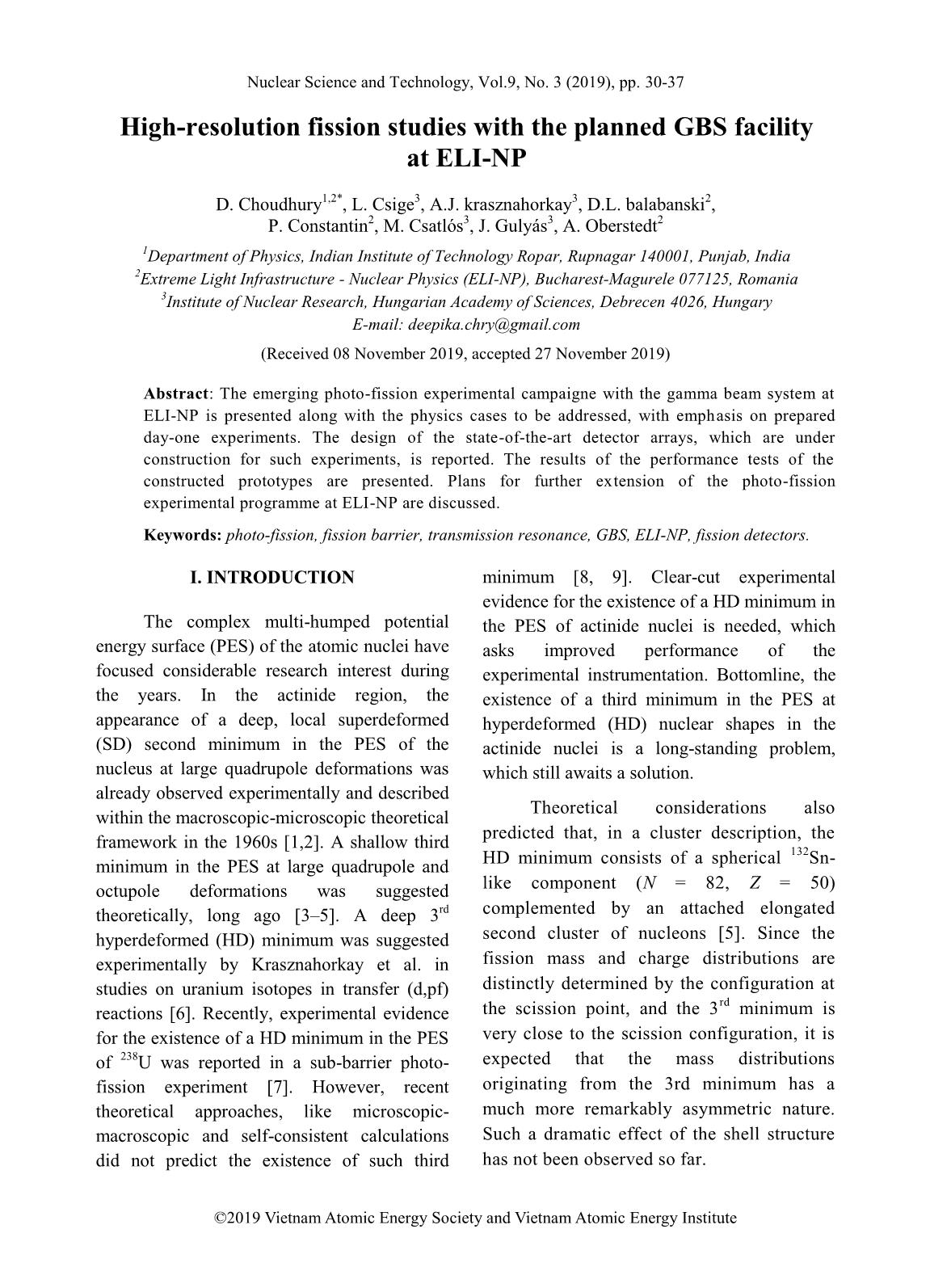
Trang 1
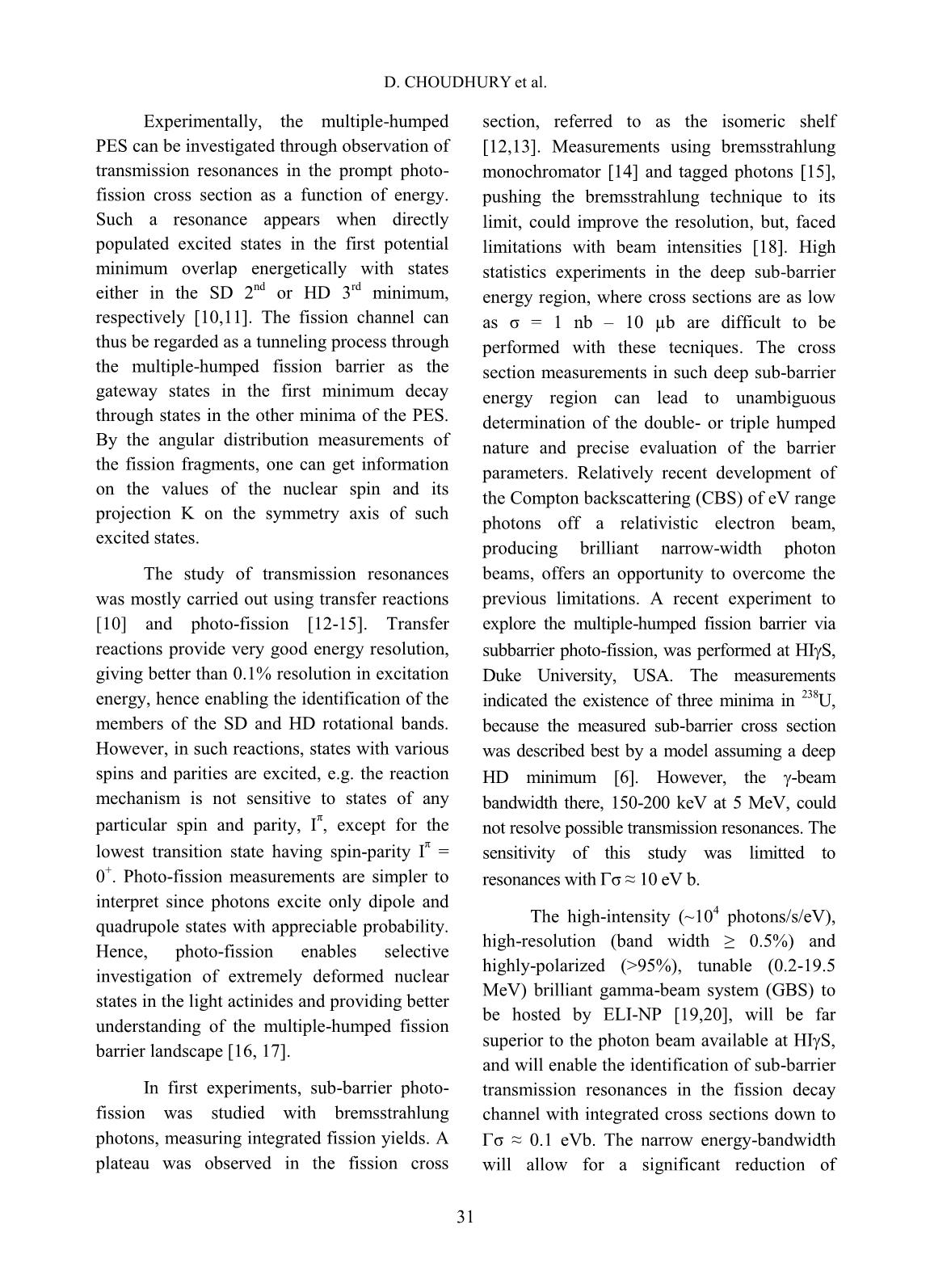
Trang 2

Trang 3
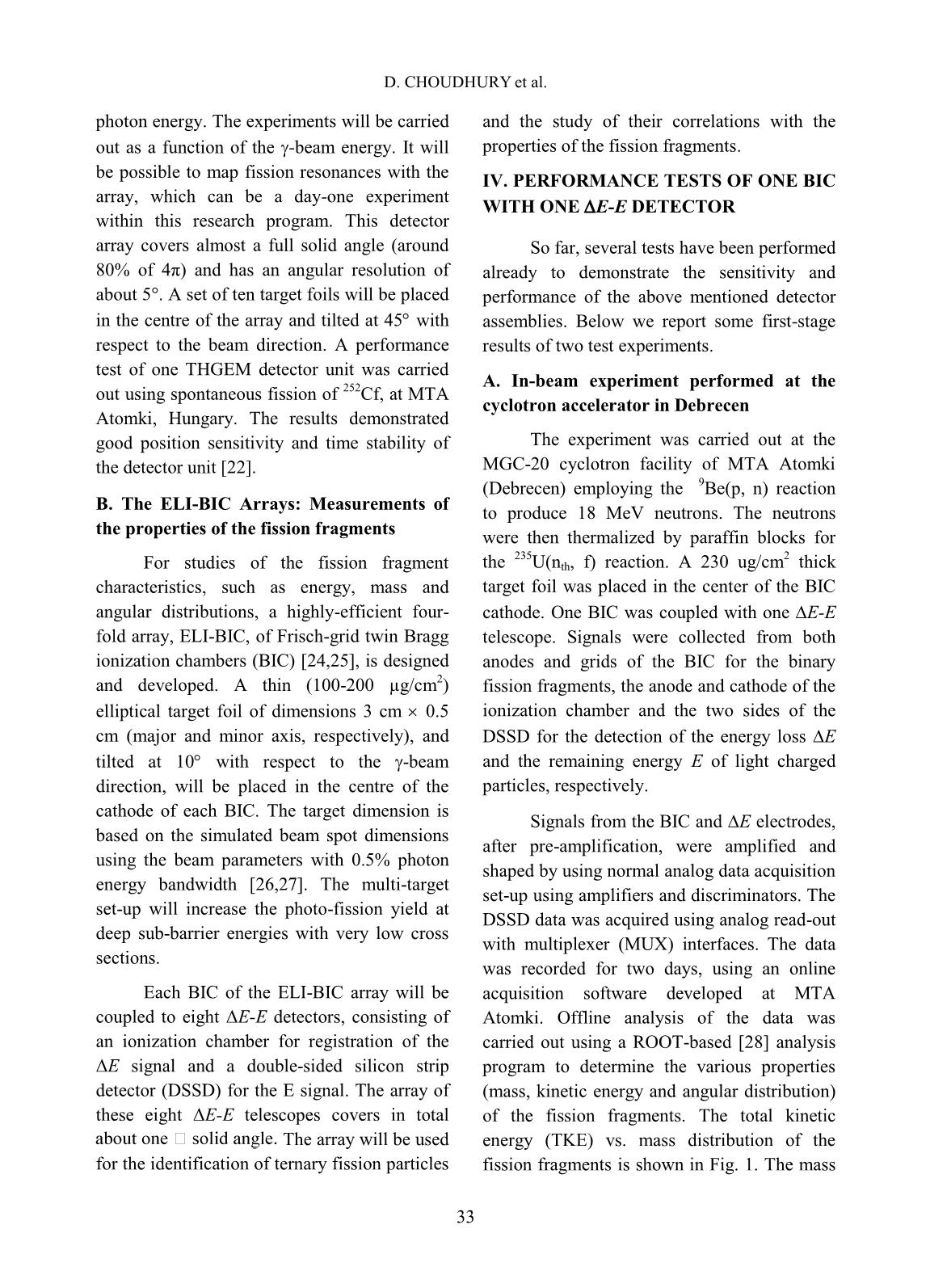
Trang 4

Trang 5
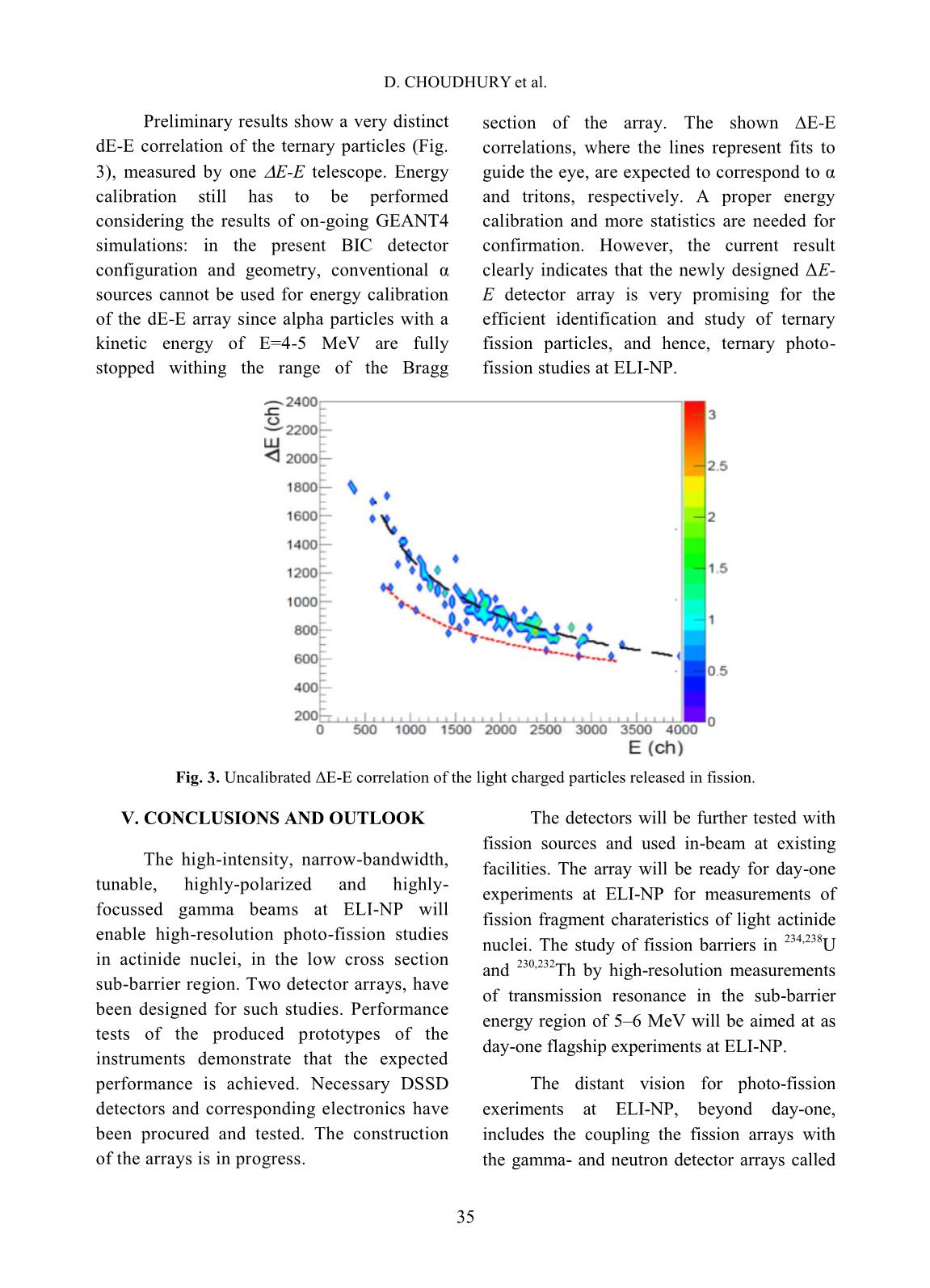
Trang 6
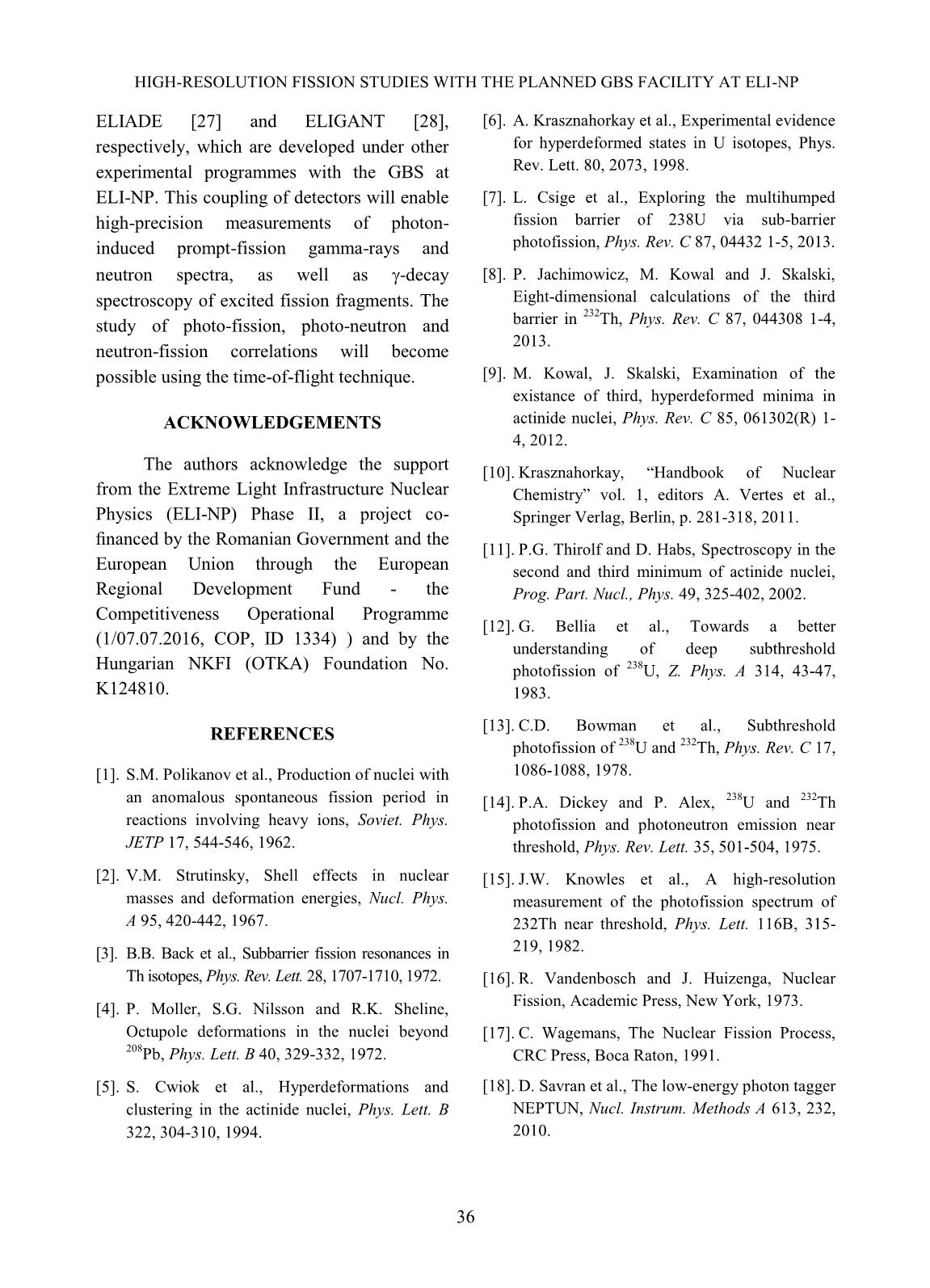
Trang 7
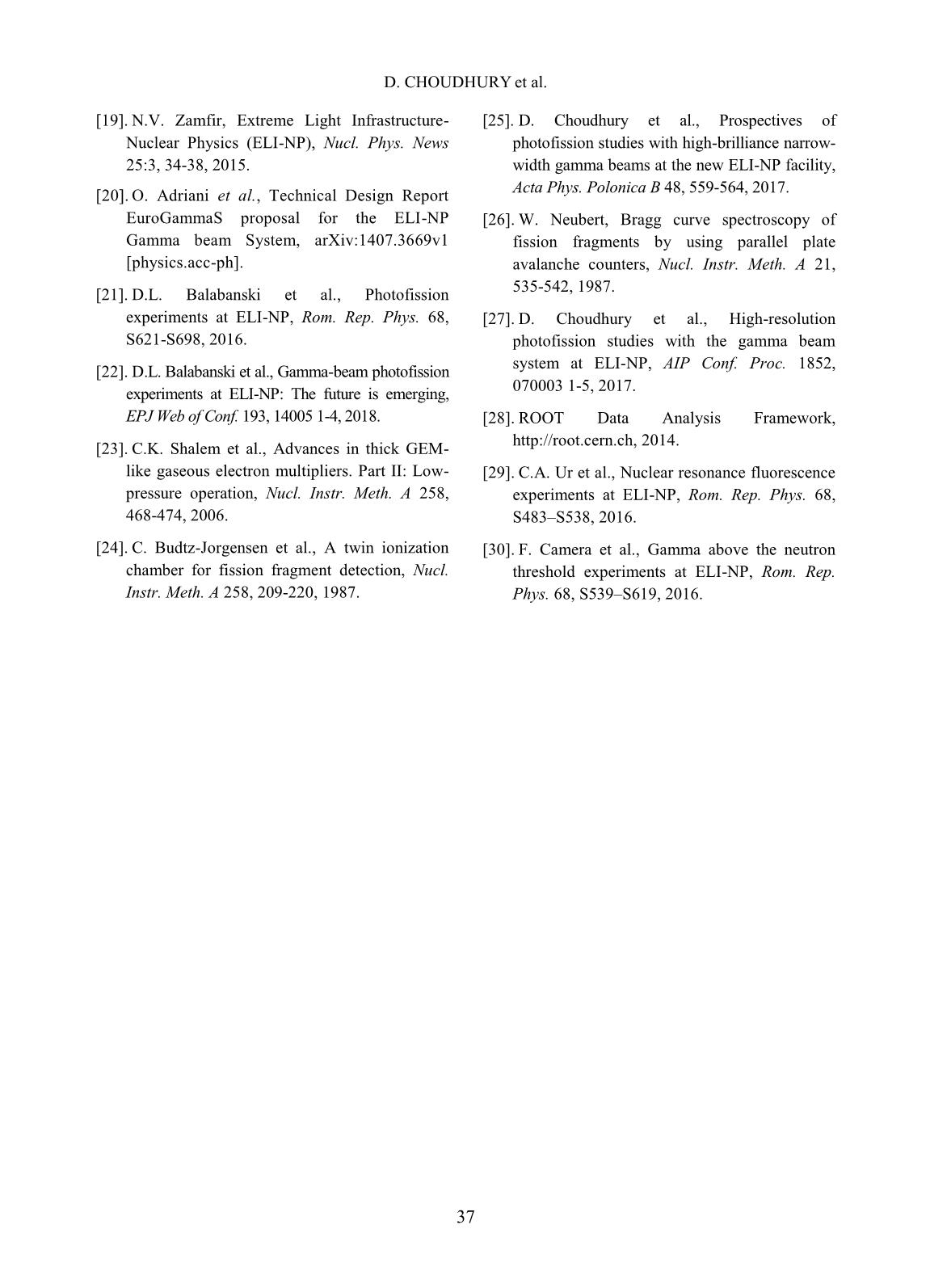
Trang 8
Bạn đang xem tài liệu "High-resolution fission studies with the planned GBS facility at ELI-NP", để tải tài liệu gốc về máy hãy click vào nút Download ở trên
Tóm tắt nội dung tài liệu: High-resolution fission studies with the planned GBS facility at ELI-NP

ibutions, following the decay of states in the different minima of the PES in the region of the light actinides. An important goal is to resolve the so far unobserved fine structure of the isomeric shelf by decomposing it into individual transmission resonances, and to observe the predicted nucleon clusterization phenomena in SD and HD states of the actinides. The polarized γ beams provide an excellent opportunity to study the space asymmetry of the angular distribution of the fission fragments and the correlation between the space asymmetry and the asymmetry of the fission process [21,22]. Another topic, which will be covered by the photo-fission programme at ELI-NP, are studies of exotic fission modes, such as ternary fission, Pb radioactivity and collinear cluster tripartition. Ternary fission has been studied so far in neutron-induced and spontaneous fission experiments, while ternary photo-fission has never been observed, due to the low cross section and the limited intensities of hitherto available photon beams. Fission studies at ELI- NP will be done with highly polarized beams, fixing the geometry of the process, which is advantageous for detailed studies. Ternary particles, being released close to the scission point, provide information about the neck formed between the two heavy fission fragments, and about fission dynamics. Hence, it is very interesting to measure light-particle emission in coincidence with fission fragments. In order to make these measurements possible, two new detector arrays are being developed based on existing, well-understood cutting-edge technologies [21,22]. These detectors will be shortly discussed in the sections below, along with presenting some test experiments demonstrating their performance. III. DETECTOR ARRAYS FOR THE PHOTO-FISSION STUDIES AT ELI-NP For the photo-fission studies with the GBS facility at ELI-NP, two detector arrays are under development: ELITHGEM and ELI- BIC. The arrays will be positioned at the closest possible distance from the -beam production point. A. The ELI-THGEM Array: Measurements of fission cross sections A multi-target detector array, ELITHGEM is under development, consisting of position sensitive detector modules based on the THick Gas Electron Multiplier (THGEM) technology [23]. The array consistes of twelve THGEM boards inside a low-pressure gas chamber, coupled with a transmission mesh and a segmented delay-line read-out electrode providing a true pixelated radiation localization. It will be used for measurements of fission cross sections and fission fragment angular distributions as a function of the D. CHOUDHURY et al. 33 photon energy. The experiments will be carried out as a function of the -beam energy. It will be possible to map fission resonances with the array, which can be a day-one experiment within this research program. This detector array covers almost a full solid angle (around 80% of 4π) and has an angular resolution of about 5°. A set of ten target foils will be placed in the centre of the array and tilted at 45 with respect to the beam direction. A performance test of one THGEM detector unit was carried out using spontaneous fission of 252 Cf, at MTA Atomki, Hungary. The results demonstrated good position sensitivity and time stability of the detector unit [22]. B. The ELI-BIC Arrays: Measurements of the properties of the fission fragments For studies of the fission fragment characteristics, such as energy, mass and angular distributions, a highly-efficient four- fold array, ELI-BIC, of Frisch-grid twin Bragg ionization chambers (BIC) [24,25], is designed and developed. A thin (100-200 µg/cm 2 ) elliptical target foil of dimensions 3 cm 0.5 cm (major and minor axis, respectively), and tilted at 10 with respect to the -beam direction, will be placed in the centre of the cathode of each BIC. The target dimension is based on the simulated beam spot dimensions using the beam parameters with 0.5% photon energy bandwidth [26,27]. The multi-target set-up will increase the photo-fission yield at deep sub-barrier energies with very low cross sections. Each BIC of the ELI-BIC array will be coupled to eight ΔE-E detectors, consisting of an ionization chamber for registration of the ΔE signal and a double-sided silicon strip detector (DSSD) for the E signal. The array of these eight ΔE-E telescopes covers in total The array will be used for the identification of ternary fission particles and the study of their correlations with the properties of the fission fragments. IV. PERFORMANCE TESTS OF ONE BIC WITH ONE E-E DETECTOR So far, several tests have been performed already to demonstrate the sensitivity and performance of the above mentioned detector assemblies. Below we report some first-stage results of two test experiments. A. In-beam experiment performed at the cyclotron accelerator in Debrecen The experiment was carried out at the MGC-20 cyclotron facility of MTA Atomki (Debrecen) employing the 9 Be(p, n) reaction to produce 18 MeV neutrons. The neutrons were then thermalized by paraffin blocks for the 235 U(nth, f) reaction. A 230 ug/cm 2 thick target foil was placed in the center of the BIC cathode. One BIC was coupled with one E-E telescope. Signals were collected from both anodes and grids of the BIC for the binary fission fragments, the anode and cathode of the ionization chamber and the two sides of the DSSD for the detection of the energy loss E and the remaining energy E of light charged particles, respectively. Signals from the BIC and E electrodes, after pre-amplification, were amplified and shaped by using normal analog data acquisition set-up using amplifiers and discriminators. The DSSD data was acquired using analog read-out with multiplexer (MUX) interfaces. The data was recorded for two days, using an online acquisition software developed at MTA Atomki. Offline analysis of the data was carried out using a ROOT-based [28] analysis program to determine the various properties (mass, kinetic energy and angular distribution) of the fission fragments. The total kinetic energy (TKE) vs. mass distribution of the fission fragments is shown in Fig. 1. The mass HIGH-RESOLUTION FISSION STUDIES WITH THE PLANNED GBS FACILITY AT ELI-NP 34 distribution of the light and heavy fragments for the so-called cold fission events, with total kinetic energy of TKE>180 MeV and thus very low fragment excitation energies, are shown in Fig. 2. At ELI-NP, the data from the BIC will be acquired using a digital acquisition system consisting of 14-bit 500 MS/s waveform digitizers facilitating both triggerless as well as triggered waveform processing, and better sensitivity of the array. Fig. 1. TKE-mass correlation of fission fragments produced from 235 U(nth, f). Fig. 2. Pre-neutron mass distribution of fission fragments produced from 235 U(nth, f). B. Performance test using a spontaneously fissioning 252 Cf source Due to the moderate neutron flux and the very small branching ratio of ternary to binary fission, light charged particle accompanied fission could not be studied in detail. Thus, a 252 Cf spontaneous fission source with a specific activity of ~30 Bq was placed in the cathode of the BIC to test the capability of the dE-E array, using the same settings of the front-end electronics as in the in-beam experiment. D. CHOUDHURY et al. 35 Preliminary results show a very distinct dE-E correlation of the ternary particles (Fig. 3), measured by one E-E telescope. Energy calibration still has to be performed considering the results of on-going GEANT4 simulations: in the present BIC detector configuration and geometry, conventional α sources cannot be used for energy calibration of the dE-E array since alpha particles with a kinetic energy of E=4-5 MeV are fully stopped withing the range of the Bragg section of the array. The shown E-E correlations, where the lines represent fits to guide the eye, are expected to correspond to α and tritons, respectively. A proper energy calibration and more statistics are needed for confirmation. However, the current result clearly indicates that the newly designed ΔE- E detector array is very promising for the efficient identification and study of ternary fission particles, and hence, ternary photo- fission studies at ELI-NP. Fig. 3. Uncalibrated ΔE-E correlation of the light charged particles released in fission. V. CONCLUSIONS AND OUTLOOK The high-intensity, narrow-bandwidth, tunable, highly-polarized and highly- focussed gamma beams at ELI-NP will enable high-resolution photo-fission studies in actinide nuclei, in the low cross section sub-barrier region. Two detector arrays, have been designed for such studies. Performance tests of the produced prototypes of the instruments demonstrate that the expected performance is achieved. Necessary DSSD detectors and corresponding electronics have been procured and tested. The construction of the arrays is in progress. The detectors will be further tested with fission sources and used in-beam at existing facilities. The array will be ready for day-one experiments at ELI-NP for measurements of fission fragment charateristics of light actinide nuclei. The study of fission barriers in 234,238 U and 230,232 Th by high-resolution measurements of transmission resonance in the sub-barrier energy region of 5–6 MeV will be aimed at as day-one flagship experiments at ELI-NP. The distant vision for photo-fission exeriments at ELI-NP, beyond day-one, includes the coupling the fission arrays with the gamma- and neutron detector arrays called HIGH-RESOLUTION FISSION STUDIES WITH THE PLANNED GBS FACILITY AT ELI-NP 36 ELIADE [27] and ELIGANT [28], respectively, which are developed under other experimental programmes with the GBS at ELI-NP. This coupling of detectors will enable high-precision measurements of photon- induced prompt-fission gamma-rays and neutron spectra, as well as -decay spectroscopy of excited fission fragments. The study of photo-fission, photo-neutron and neutron-fission correlations will become possible using the time-of-flight technique. ACKNOWLEDGEMENTS The authors acknowledge the support from the Extreme Light Infrastructure Nuclear Physics (ELI-NP) Phase II, a project co- financed by the Romanian Government and the European Union through the European Regional Development Fund - the Competitiveness Operational Programme (1/07.07.2016, COP, ID 1334) ) and by the Hungarian NKFI (OTKA) Foundation No. K124810. REFERENCES [1]. S.M. Polikanov et al., Production of nuclei with an anomalous spontaneous fission period in reactions involving heavy ions, Soviet. Phys. JETP 17, 544-546, 1962. [2]. V.M. Strutinsky, Shell effects in nuclear masses and deformation energies, Nucl. Phys. A 95, 420-442, 1967. [3]. B.B. Back et al., Subbarrier fission resonances in Th isotopes, Phys. Rev. Lett. 28, 1707-1710, 1972. [4]. P. Moller, S.G. Nilsson and R.K. Sheline, Octupole deformations in the nuclei beyond 208 Pb, Phys. Lett. B 40, 329-332, 1972. [5]. S. Cwiok et al., Hyperdeformations and clustering in the actinide nuclei, Phys. Lett. B 322, 304-310, 1994. [6]. A. Krasznahorkay et al., Experimental evidence for hyperdeformed states in U isotopes, Phys. Rev. Lett. 80, 2073, 1998. [7]. L. Csige et al., Exploring the multihumped fission barrier of 238U via sub-barrier photofission, Phys. Rev. C 87, 04432 1-5, 2013. [8]. P. Jachimowicz, M. Kowal and J. Skalski, Eight-dimensional calculations of the third barrier in 232 Th, Phys. Rev. C 87, 044308 1-4, 2013. [9]. M. Kowal, J. Skalski, Examination of the existance of third, hyperdeformed minima in actinide nuclei, Phys. Rev. C 85, 061302(R) 1- 4, 2012. [10]. Krasznahorkay, “Handbook of Nuclear Chemistry” vol. 1, editors A. Vertes et al., Springer Verlag, Berlin, p. 281-318, 2011. [11]. P.G. Thirolf and D. Habs, Spectroscopy in the second and third minimum of actinide nuclei, Prog. Part. Nucl., Phys. 49, 325-402, 2002. [12]. G. Bellia et al., Towards a better understanding of deep subthreshold photofission of 238 U, Z. Phys. A 314, 43-47, 1983. [13]. C.D. Bowman et al., Subthreshold photofission of 238 U and 232 Th, Phys. Rev. C 17, 1086-1088, 1978. [14]. P.A. Dickey and P. Alex, 238U and 232Th photofission and photoneutron emission near threshold, Phys. Rev. Lett. 35, 501-504, 1975. [15]. J.W. Knowles et al., A high-resolution measurement of the photofission spectrum of 232Th near threshold, Phys. Lett. 116B, 315- 219, 1982. [16]. R. Vandenbosch and J. Huizenga, Nuclear Fission, Academic Press, New York, 1973. [17]. C. Wagemans, The Nuclear Fission Process, CRC Press, Boca Raton, 1991. [18]. D. Savran et al., The low-energy photon tagger NEPTUN, Nucl. Instrum. Methods A 613, 232, 2010. D. CHOUDHURY et al. 37 [19]. N.V. Zamfir, Extreme Light Infrastructure- Nuclear Physics (ELI-NP), Nucl. Phys. News 25:3, 34-38, 2015. [20]. O. Adriani et al., Technical Design Report EuroGammaS proposal for the ELI-NP Gamma beam System, arXiv:1407.3669v1 [physics.acc-ph]. [21]. D.L. Balabanski et al., Photofission experiments at ELI-NP, Rom. Rep. Phys. 68, S621-S698, 2016. [22]. D.L. Balabanski et al., Gamma-beam photofission experiments at ELI-NP: The future is emerging, EPJ Web of Conf. 193, 14005 1-4, 2018. [23]. C.K. Shalem et al., Advances in thick GEM- like gaseous electron multipliers. Part II: Low- pressure operation, Nucl. Instr. Meth. A 258, 468-474, 2006. [24]. C. Budtz-Jorgensen et al., A twin ionization chamber for fission fragment detection, Nucl. Instr. Meth. A 258, 209-220, 1987. [25]. D. Choudhury et al., Prospectives of photofission studies with high-brilliance narrow- width gamma beams at the new ELI-NP facility, Acta Phys. Polonica B 48, 559-564, 2017. [26]. W. Neubert, Bragg curve spectroscopy of fission fragments by using parallel plate avalanche counters, Nucl. Instr. Meth. A 21, 535-542, 1987. [27]. D. Choudhury et al., High-resolution photofission studies with the gamma beam system at ELI-NP, AIP Conf. Proc. 1852, 070003 1-5, 2017. [28]. ROOT Data Analysis Framework, 2014. [29]. C.A. Ur et al., Nuclear resonance fluorescence experiments at ELI-NP, Rom. Rep. Phys. 68, S483–S538, 2016. [30]. F. Camera et al., Gamma above the neutron threshold experiments at ELI-NP, Rom. Rep. Phys. 68, S539–S619, 2016.
File đính kèm:
 high_resolution_fission_studies_with_the_planned_gbs_facilit.pdf
high_resolution_fission_studies_with_the_planned_gbs_facilit.pdf

